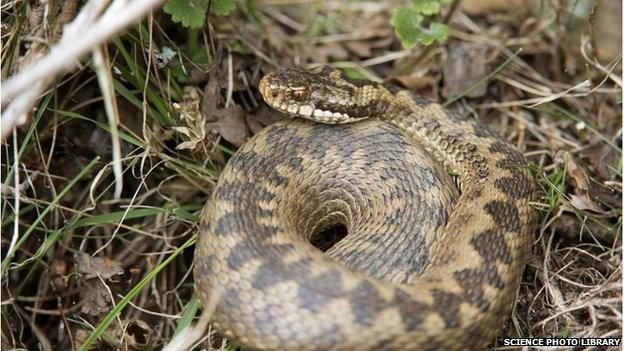Adders and barn owls struggle after bad winter
- Published
- comments

Last year was a pretty poor one for Midlands' wildlife. Filming this year's Springwatch we came across plenty of stories of low numbers and even talk of population crashes for some species.
We've focused in particular on the problems faced by adders and barn owls. Both are species that really suffered because of the snow and delayed spring in 2013.
There's nothing necessarily unnatural about a particular animal, bird or reptile having a really bad year, failing to breed and for their population to shrink. What is important is how they recover afterwards.
And here is where adders and barn owls face similar problems. They've both lost their homes.
Islands of land
Adders like hiding in bracken, which is usually seen as a problem to be removed.
Barn owls, of course, like to live in barns on farms, but for some time we've been converting their homes into nice homes for us.
Both species also face problems with their wider habitat. The landscape is becoming fractured and fragmented, crisscrossed by roads and paths, so what were once large territories have become small islands of land.

It means adders can no longer roam as far as they used to and barn owls often meet a nasty end as they fly low over a road and get hit by a car.
We've seen the hard work people are doing to help our barn owls recover. In Staffordshire the Barn Owl Action Group has just put up their 400th barn owl box, external. And Staffordshire Wildlife is conducting a county-wide survey, external to learn more about those owls that are left.
This year, at least, it looks like numbers could be recovering. At the moment teams are out right across the Midlands checking on barn owl chicks.
Anecdotally things are looking much better than last year. In the Tame Valley there are 15 chicks in three boxes. Compare that to last year when there were none. Proper survey results will be available soon.
Gloomy
For adders the picture is not so bright. While people are happy to put up a barn owl box in their garden, they are less keen to create habitats for our only venomous snake.
But there are moves to learn more about their decline.
A small study looking at the problems of predation by pheasants, external on the Malverns is to be expanded this year. And the importance of bracken for adders is something conservationists do think about now when managing the landscape.
For adders in the Midlands things do look gloomy though, with extinction in Warwickshire and a single site left in Staffordshire.
There are people out there trying to help them, external. The worry is another bad winter and spring might mean all those efforts to save our Midlands adders won't be enough.